
Ryman Auditorium is a historic 2,362-seat live-performance venue and museum located at 116 Rep. John Lewis Way North, in the downtown core of Nashville, Tennessee, United States. A Rock & Roll Hall of Fame Landmark, National Historic Landmark, and the former home of the Grand Ole Opry, it is one of the most influential and revered concert halls in the world. It is best known as the home of the Grand Ole Opry from 1943 to 1974. It is owned and operated by Ryman Hospitality Properties, Inc. Ryman Auditorium was listed on the National Register of Historic Places in 1971 and was later designated as a National Historic Landmark on June 25, 2001, for its pivotal role in the popularization of country music. A storied stage for Rock & Roll artists for decades, the Ryman was named a Rock & Roll Hall of Fame Landmark in 2022.

Munson is a regional fine arts center founded in 1919 and located in Utica, New York. The institute has three program divisions, museum of art, performing arts and school of art.

Marr & Holman was an architectural firm in Nashville, Tennessee known for their traditional design. Notable buildings include the Nashville Post Office and the Milliken Memorial Community House in Elkton, Kentucky.
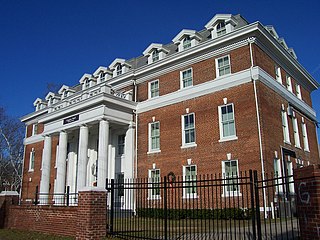
Allen University is a private historically black university in Columbia, South Carolina, United States. It has more than 600 students and still serves a predominantly Black constituency. The campus is listed on the National Register of Historic Places as Allen University Historic District.

This is a list of sites in Minnesota which are included in the National Register of Historic Places. There are more than 1,700 properties and historic districts listed on the NRHP; each of Minnesota's 87 counties has at least 2 listings. Twenty-two sites are also National Historic Landmarks.

This is a list of the buildings, sites, districts, and objects listed on the National Register of Historic Places in American Samoa. There are currently 31 listed sites spread across the three districts of American Samoa. There are no sites listed on the unorganized atoll of Swains Island.

This is a list of more than 1,100 properties and districts in Nebraska that are on the National Register of Historic Places. Of these, 20 are National Historic Landmarks. There are listings in 90 of the state's 93 counties.
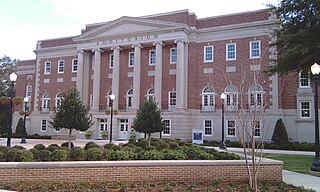
Foster Auditorium is a multi-purpose facility at the University of Alabama in Tuscaloosa, Alabama. It was built in 1939 as a Works Progress Administration project and has been used for Alabama basketball, women's sports, graduations, lectures, concerts, and other large gatherings, including registration. Its status as the largest indoor building on campus came to an end in 1968 with the opening of the Memorial Coliseum. The building housed the Department of Kinesiology until 2006. In April 2009, the University announced a major renovation for the auditorium. After the renovation, the Crimson Tide women's basketball and volleyball programs moved back to Foster Auditorium, their original home.
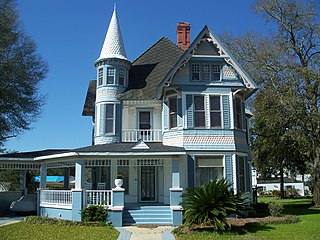
The DeFuniak Springs Historic District is a U.S. historic district located in DeFuniak Springs, Florida. DeFuniak Springs, originally Lake DeFuniak, was named after Fred DeFuniak, the chief executive of the Louisville and Nashville Railroad. The district is bounded by Nelson and Park Avenues and 2nd and 12th Streets. It contains 172 historic buildings and 2 objects.

Crouse College, also known as Crouse Memorial College and historically as John Crouse Memorial College for Women, is a building on the Syracuse University campus. It was funded by John R. Crouse, a wealthy Syracuse merchant with the White family, and designed by Archimedes Russell. It is built in the Romanesque revival—Richardsonian Romanesque style.

Rockport High School is a public high school in Rockport, Massachusetts.

Easley High School Auditorium is a historic building built in 1909 in Easley, South Carolina and now on the National Register of Historic Places. It is historically significant for its long association with education and civic life in Easley in the first half of the 20th century. The building served as Easley's first and only high school from 1909 to 1940 and was central to the early experience and training of almost every local resident of that period.

This is a list of the National Register of Historic Places listings in Crow Wing County, Minnesota. It is intended to be a complete list of the properties and districts on the National Register of Historic Places in Crow Wing County, Minnesota, United States. The locations of National Register properties and districts for which the latitude and longitude coordinates are included below, may be seen in an online map.

This is a list of the National Register of Historic Places listings in Kandiyohi County, Minnesota. It is intended to be a complete list of the properties and districts on the National Register of Historic Places in Kandiyohi County, Minnesota, United States. The locations of National Register properties and districts for which the latitude and longitude coordinates are included below, may be seen in an online map.
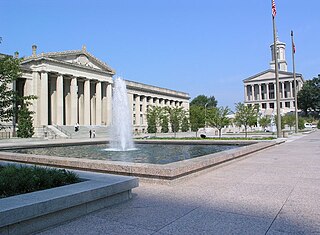
The War Memorial Auditorium is a 2,000-seat performance hall located in Nashville, Tennessee. Built in 1925, it served as home of the Grand Ole Opry between 1939 and 1943. It is also known as the War Memorial Building, the Tennessee War Memorial, or simply the War Memorial. It is located across the street from, and is governed by, the Tennessee Performing Arts Center, and is also adjacent to the Tennessee State Capitol. It received an architectural award at the time of its construction, and was listed on the National Register of Historic Places in 2017.
Cole Building or Cole Block or variations may refer to:
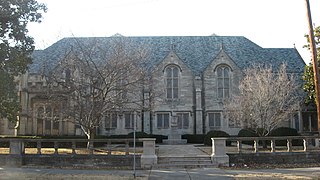
The Thomas W. Phillips Memorial is a historic building in Nashville, Tennessee, United States, owned by Vanderbilt University. It was home to the Disciples of Christ Historical Society until the building was purchased by Vanderbilt in 2015. It was built in 1956. It has been listed on the National Register of Historic Places since November 9, 2006.

The Cole Memorial Building is a historic municipal event hall in Pequot Lakes, Minnesota, United States. It was built in 1937 with New Deal funding, generating jobs and revenue for a community suffering the effects of the Great Depression. With an auditorium large enough to seat 400 people, the Cole Memorial Building served as a key venue for numerous local events. From 1941 to 1967 it was converted into a municipally-run cinema, the Lakes Theater, whose profits were channeled back into community improvements. The building was listed on the National Register of Historic Places in 2004 as the A.L. Cole Memorial Building for having local significance in the themes of entertainment/recreation, politics/government, and social history. It was nominated for illustrating the long-lived benefits and substantial return on investment achieved with New Deal funding.
Colonel Edmund William Cole was an American Confederate veteran and businessman. He was the president of the Nashville, Chattanooga and St. Louis Railway, and the founder of the American National Bank.

The Richland Center City Auditorium is a three-story red brick public auditorium in Richland Center, Wisconsin. It was built in 1912 as a combination city hall, theatre, and clubhouse. The building was listed on the National Register of Historic Places in 1980 for its significance in local social and political history. It was also listed as a contributing structure to the Court Street Commercial Historic District in 1989. The auditorium currently houses the Richland County Performing Arts Center.



















